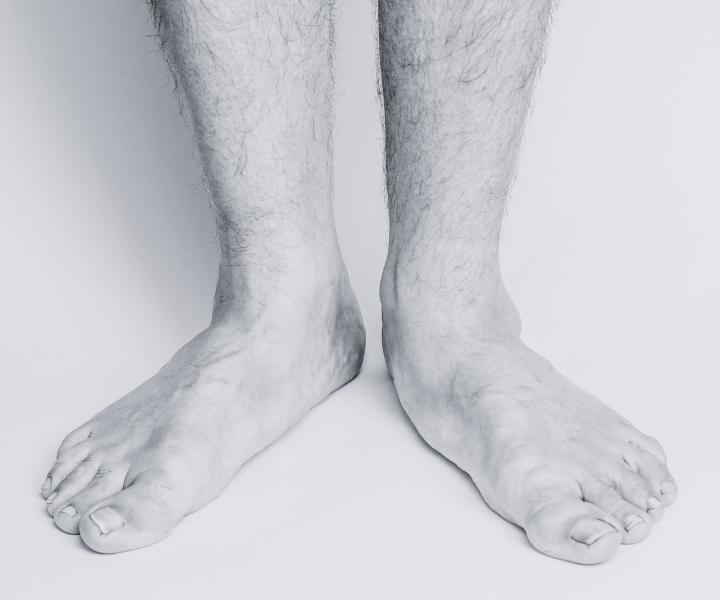What are flat feet
Flat feet, also known as fallen arches, can cause discomfort and affect mobility.
Flat feet refer to a condition in which the arches of the feet have collapsed or are significantly reduced. Normally, the arches of the feet provide shock absorption and distribute body weight evenly across the foot during standing, walking, and running. However, in individuals with flat feet, the entire sole of the foot comes into contact with the ground.
Causes of Flat Feet
Flat feet can have various causes, including:
- Genetic Factors: Some individuals are born with flat feet due to inherited structural abnormalities in the foot. The condition may run in families.
- Overpronation: Overpronation occurs when the feet roll excessively inward during walking or running. This motion can contribute to the development of flat feet over time.
- Foot and Ankle Injuries: Trauma or injuries to the foot or ankle can lead to changes in foot structure, potentially resulting in flat feet.
- Ageing: As we age, the supportive structures in the feet, including ligaments and tendons, may weaken and contribute to the development of flat feet.
Symptoms of Flat Feet
Flat feet can cause a range of symptoms, including:
- Foot and Ankle Pain: Pain and discomfort can occur along the inner arch, heel, and ankle areas. This pain may worsen with prolonged standing or walking.
- Fatigue and Aching: Individuals with flat feet often experience fatigue and aching in the feet, particularly after prolonged physical activity or periods of standing.
- Difficulty with Balance and Stability: The altered foot structure can affect balance and stability, making activities such as running or participating in sports more challenging.
- Lower Leg Pain: Flat feet can contribute to pain and muscle fatigue in the lower legs, including the calves and shins.
How Can a Podiatrist Diagnose Flat Feet?
If you suspect you have flat feet or are experiencing related symptoms, a podiatrist can perform a comprehensive biomechanical examination to diagnose the condition. The diagnostic process includes:
- Medical History Review: Your podiatrist will discuss your symptoms, medical history, and any previous foot or ankle injuries
- Physical Examination: Your podiatrist will visually inspect your feet and observe how you stand, walk, and perform certain movements. They may assess the flexibility of your arches and evaluate the alignment of your feet and ankles.
- Gait Analysis: By analysing your walking or running pattern, a podiatrist can determine if overpronation or other gait abnormalities are contributing to your flat feet.
- Imaging Tests: In some cases, your podiatrist may request imaging tests, such as X-rays or an MRI, to evaluate the bones and structures within the foot and determine the severity of the condition.
How Can a Podiatrist Treat Flat Feet?
Podiatrists offer various treatment options for individuals with flat feet, tailored to their specific needs. The following are common approaches to managing flat feet:
Orthotic Devices: Custom-made orthotic devices, such as arch supports or shoe inserts, can be prescribed to provide support to the arches and improve foot function. Orthotics help distribute pressure evenly across the foot and alleviate discomfort.
Footwear Recommendations: A podiatrist can recommend footwear with appropriate arch support and stability features. Shoes that offer good arch support and cushioning can help reduce pain and provide additional comfort.
Physical Therapy: Physical therapy can play a crucial role in strengthening the muscles and improving foot and ankle stability. Specific exercises and stretches prescribed by a podiatrist can target the muscles that support the arches, helping to alleviate symptoms.
Medications: Over-the-counter pain relievers or anti-inflammatory medications may be recommended to manage pain and reduce inflammation associated with flat feet. However, these medications should be used under the guidance of a healthcare professional.
Flat Feet Treatment and Prevention
While flat feet cannot be completely cured, there are steps individuals can take to manage the condition and reduce symptoms:
- Maintain a Healthy Weight: Excess weight can put additional strain on the feet, exacerbating flat foot symptoms. Maintaining a healthy weight can help reduce this strain.
- Supportive Footwear: Opt for shoes that offer good arch support, cushioning, and stability. Avoid wearing shoes with high heels or thin soles, as they can worsen symptoms.
- Avoid Prolonged Standing or Walking: If your job or daily activities require prolonged standing or walking, take breaks and rest your feet whenever possible to alleviate fatigue and discomfort.
- Regular Exercise: Engaging in low-impact exercises, such as swimming or cycling, can help maintain overall fitness without putting excessive strain on the feet.
- Consulting your podiatrist. If you are concerned about your feet and think your arches are falling, or your children are displaying signs of flat feet, it is important to see your Podiatrist so they can tailor a prevention and treatment plan to your specific needs.
Summary
Flat feet can cause discomfort and affect an individual’s mobility and quality of life. However, with the help of a podiatrist, proper diagnosis and treatment can significantly alleviate symptoms and improve foot function.
If you, or a family member are experiencing symptoms of Flat Feet and would like to visit us for Flat Feet Treatment in Melbourne, please call 03 9878 4566 or email [email protected] and we can book you in for a Biomechanical Assessment in the closest clinic location that suits you; Blackburn, Melbourne CBD, Newport, Elsternwick, Caroline Springs or Springvale.

